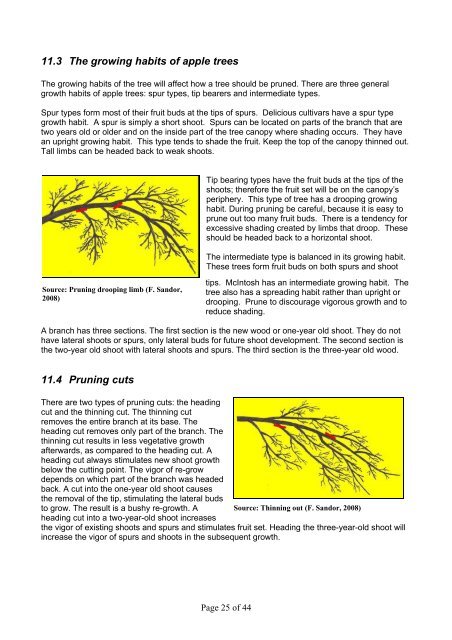Apple Production Manual, Roots of Peace, Nov. 2008
Apple Production Manual, Roots of Peace, Nov. 2008
Apple Production Manual, Roots of Peace, Nov. 2008
Create successful ePaper yourself
Turn your PDF publications into a flip-book with our unique Google optimized e-Paper software.
11.3 The growing habits <strong>of</strong> apple trees<br />
The growing habits <strong>of</strong> the tree will affect how a tree should be pruned. There are three general<br />
growth habits <strong>of</strong> apple trees: spur types, tip bearers and intermediate types.<br />
Spur types form most <strong>of</strong> their fruit buds at the tips <strong>of</strong> spurs. Delicious cultivars have a spur type<br />
growth habit. A spur is simply a short shoot. Spurs can be located on parts <strong>of</strong> the branch that are<br />
two years old or older and on the inside part <strong>of</strong> the tree canopy where shading occurs. They have<br />
an upright growing habit. This type tends to shade the fruit. Keep the top <strong>of</strong> the canopy thinned out.<br />
Tall limbs can be headed back to weak shoots.<br />
Source: Pruning drooping limb (F. Sandor,<br />
<strong>2008</strong>)<br />
Tip bearing types have the fruit buds at the tips <strong>of</strong> the<br />
shoots; therefore the fruit set will be on the canopy’s<br />
periphery. This type <strong>of</strong> tree has a drooping growing<br />
habit. During pruning be careful, because it is easy to<br />
prune out too many fruit buds. There is a tendency for<br />
excessive shading created by limbs that droop. These<br />
should be headed back to a horizontal shoot.<br />
The intermediate type is balanced in its growing habit.<br />
These trees form fruit buds on both spurs and shoot<br />
tips. McIntosh has an intermediate growing habit. The<br />
tree also has a spreading habit rather than upright or<br />
drooping. Prune to discourage vigorous growth and to<br />
reduce shading.<br />
A branch has three sections. The first section is the new wood or one-year old shoot. They do not<br />
have lateral shoots or spurs, only lateral buds for future shoot development. The second section is<br />
the two-year old shoot with lateral shoots and spurs. The third section is the three-year old wood.<br />
11.4 Pruning cuts<br />
There are two types <strong>of</strong> pruning cuts: the heading<br />
cut and the thinning cut. The thinning cut<br />
removes the entire branch at its base. The<br />
heading cut removes only part <strong>of</strong> the branch. The<br />
thinning cut results in less vegetative growth<br />
afterwards, as compared to the heading cut. A<br />
heading cut always stimulates new shoot growth<br />
below the cutting point. The vigor <strong>of</strong> re-grow<br />
depends on which part <strong>of</strong> the branch was headed<br />
back. A cut into the one-year old shoot causes<br />
the removal <strong>of</strong> the tip, stimulating the lateral buds<br />
to grow. The result is a bushy re-growth. A Source: Thinning out (F. Sandor, <strong>2008</strong>)<br />
heading cut into a two-year-old shoot increases<br />
the vigor <strong>of</strong> existing shoots and spurs and stimulates fruit set. Heading the three-year-old shoot will<br />
increase the vigor <strong>of</strong> spurs and shoots in the subsequent growth.<br />
Page 25 <strong>of</strong> 44



